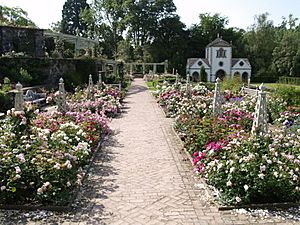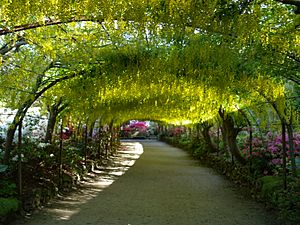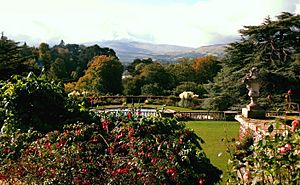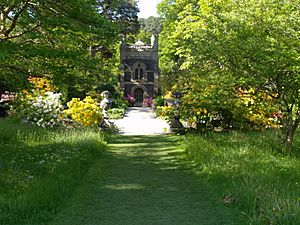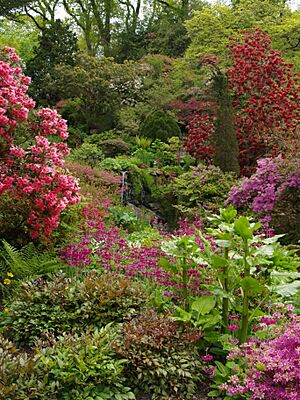Bodnant Garden facts for kids
Bodnant Garden is a beautiful garden owned by the National Trust. It's located near Tal-y-Cafn in Conwy, Wales. The garden looks out over the Conwy Valley towards the amazing Carneddau mountains.
This special garden was started in 1874 and was looked after by five generations of the same family. In 1949, they gave it to the National Trust so everyone could enjoy it. Bodnant Garden covers 80 acres of hillside. It has fancy Italian-style terraces and wilder areas with plants from all over the world. You can also find a deep gorge garden called The Dell, many old trees, and a waterfall.
Since 2012, new parts of the garden have opened, like the Winter garden, Old Park Meadow, and The Far End, which is a garden by the river. Furnace Wood and Meadow opened in 2017. More new areas are planned for the future!
Bodnant Garden is very popular, with over 270,000 visitors in 2019. It's famous for its Laburnum arch, which is the longest in the UK. When it flowers in May and June, it looks like a tunnel of golden flowers! The garden is also known for its connection to "plant hunters" from the early 1900s. These explorers brought back many plants that helped create the garden's special collections of Magnolia, Embothrium, Eucryphia, and Rhododendron forrestii.
Contents
Garden History
How it Started
The garden was started by Henry Davis Pochin. He was a clever chemist from the Victorian era who became very rich by inventing a way to make soap ingredients white. He bought the Bodnant estate in 1874.
Pochin hired Edward Milner, a talented garden designer, to help him. Together, they changed the land around the old house. They planted many American and Asian conifer trees (like pine trees) along the River Hiraethlyn, creating a special forest called a Pinetum. They also made a beautiful woodland and water garden in the valley. In the upper part of the garden, they created the famous Laburnum Arch and glasshouses for exotic plants. Pochin also built "The Poem," a family mausoleum (a building where family members are buried).
Family Continues the Work
Henry Pochin's daughter, Laura McLaren, Baroness Aberconway, continued to develop the garden. She was also a strong supporter of women's rights. Laura inspired her son, Henry McLaren, 2nd Baron Aberconway, to take over the garden in 1901.
Henry McLaren made many big changes to the garden. He helped pay for plant hunting trips by explorers like Ernest Wilson and George Forrest. These explorers brought back amazing plants from China and the Himalayas, including magnolias and rhododendrons. Henry also started a program to create new types of rhododendrons.
From 1905 to 1914, Henry finished building the garden's five large terraces. This was a huge job, as workers had to move a lot of earth by hand to level the hillside. They also built strong granite walls to protect the new plants from overseas. In 1938, the Pin Mill building was added to the Canal Terrace. This building was originally from Gloucestershire and was saved by Henry, who had it taken apart and rebuilt brick by brick at Bodnant.
Henry McLaren later became the president of the Royal Horticultural Society for 22 years. In 1949, he gave Bodnant Garden to the National Trust. It was only the second garden ever accepted by the National Trust for its beauty alone.
Later Years
Famous garden writers like Vita Sackville-West visited Bodnant Garden in 1952 and were very impressed. They called it one of the "wonders of the world."
For many years, the garden continued to grow thanks to a partnership between three generations of the McLaren family (Henry, Charles, and Michael) and three generations of head gardeners. Charles McLaren, like his father, also became president of the RHS. His sister, Dr. Anne McLaren, was a leading scientist who helped develop IVF.
Today, Michael McLaren, Charles's son, manages the garden. New head gardeners have continued to care for and develop Bodnant Garden.
Amazing Plants and Plant Hunters
Bodnant Garden is famous for its incredible collection of plants, many of which were brought back by brave explorers from the 1800s and early 1900s. The garden has four special "National Collections" of plants: Rhododendron forrestii, Magnolia, Eucryphia, and Embothrium. It also has twenty-two "Champion Trees", which are noted for being very old, tall, or special.
Early Plantings
Henry Pochin, the garden's founder, planted many of the large conifer trees you see today. This includes the cedars on the Lily Terrace (from Africa and the Middle East) and the Pinetum in The Dell. The Pinetum has American and Asian conifers like the Douglas Fir, Monterey Pine, and the giant Sequoiadendron giganteum (Giant Redwood).
The Plant Hunters' Discoveries
Later, Henry McLaren, Pochin's grandson, sponsored many plant hunting trips. These trips brought huge numbers of rhododendrons, camellias, and magnolias to Britain.
- Ernest Wilson traveled a lot in China. He brought back seeds of the Handkerchief Tree (Davidia involucrata), which still grows at Bodnant. He also found many magnolias and other trees like the Acer griseum. Wilson also discovered the beautiful Lilium regale, which now grows on the rose terraces.
- George Forrest was another experienced explorer who collected plants in western China and Tibet. His trips brought back seeds for many new rhododendrons. The gardeners at Bodnant were able to grow these plants in large numbers. Lord Aberconway and his head gardener then created new types of rhododendrons, called the Bodnant Hybrid Rhododendrons. The garden now has about 350 different kinds! Forrest also brought back the Primula bulleyana, a type of primrose, which you can still see around the garden.
- Frank Kingdon-Ward explored the Himalayas in the 1920s and 1930s. He introduced many new species to Bodnant Garden, including the stunning Himalayan Blue Poppy (Meconopsis betonicifolia).
- Harold Comber was sponsored by garden owners, including Lord Aberconway, to travel in South America in 1925. This trip helped create two of Bodnant's national collections: the Chilean Flame Tree (Embothrium coccineum) and Eucryphia. Some of Comber's other plants from South America, like the Crinodendron patagua, are still growing at Bodnant today.
Bodnant in the Media
- In the summer of 2018, parts of the movie The Secret Garden were filmed at Bodnant.
- The garden was also featured on BBC One’s Antiques Roadshow in February 2021.


